I think nougat has gotten a bad rap, at least in the States. Most nougat that gets eaten these days is like the puffy, empty sweet nougat in Snickers bars. I didn’t think it was all that great either until we found this book: Chocolates and Confections by Peter Greweling. The author is a professor at the Culinary Institute of America and this book could function as a class text book, coffee table book, or a basis for starting a business in chocolate or candy making. I am sure this book has been at the core of all the “how to open my own chocolate shop” Google searches, too.
We got this book last year and had a blast learning how to make molded chocolates, caramels, and nougats, which we handed out for Christmas last year. This week brought a couple of excuses to brush off the book and see if we couldn’t officially get our badges.
On our visit to Schaner Farms in the Little Italy Farmer’s Market this week (who we religiously visit at opening time every week to get our eggs), we came across a pretty basket of Kaffir limes.
These limes are usually not eaten much, but the leaves are used extensively in Southeast Asian cooking. The flavor is pretty unique and is dark green, fresh, and slightly bitter lime. The basis of nougat can often be a candied fruit or rind and once I saw these, I knew we had to try out candied Kaffir lime peel.
The Greweling book lays out how to make candied or “confit” citrus peel. You first blanch peel from quartered citrus to remove the bitterness.
Kaffir limes are quite bitter — their peel will make your lips tingly if you try to eat it straight. So, instead of blanching the three times recommended, we added a fourth. After the fourth, we could not taste much residual bitterness in the peel. Here they are after the last blanching.
After blanching, you simmer the peels in a sugar/glucose solution for anywhere from 60 min to 2 1/2 hours (he says 90 min, but we’ve always needed longer) at a very low heat. In order to keep them submerged, we used a drop lid. We first learned about drop lids when we tried Japanese cooking. The Japanese do a lot of simmering and use a drop lid to keep the food submerged under water for even cooking. We got ours at Daiso, the Japanese equivalent of a dollar store (but a lot better). You could also use a plate.
We checked on them every 10 min or so to make sure they were not simmering too hard (the skins get tough if they boil). They go from opaque white in color to purely translucent over time. We cooked them for 10 min after they had first all gone translucent. This time, it took about 2 hrs 15 min. Here they are when they are done.
Which brings us back to nougat. Nougat is pretty close in many ways to meringue: egg whites that have been stiffened with boiled honey and/or sugar. The less water, the harder the meringue and the harder the nougat. Meringues can be baked to completely dry them out. In nougat, water is removed by boiling the sugar and honey to higher temperatures before adding it to the egg whites. You can, as Greweling does, also use powered egg whites instead of regular whites and this removes more water.
Today, we’re making a French-style “Montelimar” nougat. The region of Montelimar in south-eastern France is renowned for their nougat. According to our friends at Maison en Provence, a very cute housewares store specializing in products from Provence, Montelimar nougat should be white, chewy, and only made of almonds, pistachios, sugar, and lavender honey.
Greweling deviates from this in his Montelimar nougat and adds hazelnuts, dried pear, dried apricot, and dried cherries, and regular (!!) honey. We’ve tried a bunch of versions — almonds, pistachios, and dried cherry; with added candied yuzu; a chocolate version with candied Seville orange peel; with French lavender honey; with Spanish lavender honey; and with Costco clover honey. Today, we are making a Thai-inspired nougat: candied Kaffir lime peel, candied ginger, toasted macadamias, and French lavender honey.
Lavender Honey Interlude
Most lavender honey that is available in the States is lavender infused honey. So, it pretty much tastes like soap. True lavender honey, on the other hand, is from bees that have lived on nothing but lavender flowers. It fills your nose with a heady floral sweetness that makes other honeys seem coy — nothing like soap. We’ve tried Spanish lavender honey ($10 for 12 oz.) and French lavender honey (Ours Brun brand, $20 for 13 oz.). Turns our the Spanish bees have nothing on the French — as for the price, we just have to suck it down. Even if it triples the cost of making nougat, the quality of the honey is directly related to the heavenliness of the nougat, no matter what else you put into it.
This recipe is all about timing. It takes about 45 min to get everything set up and then it all executes in about 15. You have the egg whites sitting in the mixer; all the inclusions (nuts & fruit) toasted if needed and waiting in a warm oven; sugar, corn syrup, water, and vanilla sitting in one pot; and honey in another. You turn on the mixer with the whites when the honey reaches 226 F and then the fun starts.
You begin by making an Italian meringue. This is whipped egg whites, into which you pour boiled honey while whipping. If you follow Greweling to the letter, you start with some powdered egg whites and ultimately end up with a hard-ish nougat. We use 70g egg whites (about 2) to start instead. Using the same temperatures for the rest of the recipe results in a great soft, chewy texture.
As soon as the honey reaches 248, you have turned on the sugar solution to boil, and take the honey off the stove and pour it into the whipping whites (pour down the side so the hot honey doesn’t get in the whisk!).
You then wait for the sugar solution (sugar, corn syrup, water, and in our case a Tahitian vanilla bean) to boil to a temperature of 300-311. Any hotter and the glucose in the corn syrup will start to caramelize and you’ll get nougat with a brown hue. For this, and the honey step, a good candy thermometer is important. We have ruined a couple digital probe-style thermometers because they have gotten too hot in the sugar or on the bottom of the pot. Greweling uses 311 here, but you could go a little lower for chewier texture.
Glucose/Corn Syrup/Maltose huh?
Greweling uses “glucose” in all his recipes, which is corn syrup, but he uses the general term because it could be made industrially from any starch. Corn, when it is in the cob, is mostly made up of starch, which is a big molecule made up of a bunch of glucose (a type of sugar) molecules stuck together. It can be broken down with enzymes — in your mouth, starches get broken down into sugars by an enzyme in your saliva called amylase (you could make your own corn syrup by chewing on corn starch, but that might be taking “homemade” a little far). Industrially, people use enzymes, too. The result is a solution made up of glucose, maltose (2 glucose molecules stuck together), and some larger molecules made of glucose, the whole thing of which is called corn syrup. Karo syrup is corn syrup with vanilla flavoring added. We get our syrup at the Korean market Zion, where they call it malt (maltose!) syrup. It has the advantages that it has no vanilla and is a third the price of Karo. None of these syrups taste very sweet. High fructose corn syrup (which we are not using here), has another step to convert the glucose to fructose. The stuff in soda is about 55% fructose to 45% glucose, making it about as sweet as table sugar or honey.
Vanilla Sourcing
Go into a random grocery store and buy a vanilla bean and you will seriously wonder what all the fuss is about. They will charge you $4-10 and it will be dry, old, and pretty tasteless. Grocery stores just don’t get the traffic to warrant having good vanilla and you are better off using extract. The internet, however, can come to your rescue. We found this site from a guy that seriously knows his vanilla. He seemed to think that Beanilla was a pretty good place to get beans and we followed his advice, getting soft, pliant, vibrantly fragrant beans for $1 – 1.50 each. We tried 5 different kinds and settled on our 2 favorites: Mexican, a smooth, creamy vanilla with deep notes (think “The Most Interesting Man in the World”); and Tahitian, a bright, fruity, floral vanilla (think a stylish, flamboyant gay man about to throw a party on a gorgeous tropical island).
After you pour the sugar solution into the honey meringue and whip for a few minutes, you are ready to mix in the inclusions. If you’re not a purist, these can be anything. This time around we have diced Kaffir lime peel, candied ginger, and toasted macadamia nuts. Since we were going with a Thai theme, we also used coconut oil (also a hard fat) instead of cocoa butter. Here is the nougat going into the bowl with the inclusions and coconut oil.
When to add cocoa butter?
In the recipe, you also add melted cocoa butter to the nougat to help with mouth feel and to ease in cutting it later. The recipe says to add it in the mixer. This introduces all sorts of drama. First, the nougat, which was all puffy, collapses. Then, little pieces of nougat (which is very hot!) come flying off the mixer unless you have it covered. It is supposed to come together again, but we’ve always ended up using a hair dryer to heat up the nougat to get it to come together again. Luckily, someone on eGullet (Drewman, see here) had the bright idea of adding the cocoa butter to the inclusions instead. This works beautifully.
After mixing it up, you pour it out onto sheets of rice paper. It helps the nougat to keep from sticking to things, like the plastic that you wrap it up in. The paper dissolves quickly in your mouth. We got our rice paper from a cake decorating store called Do it with Icing! — they sell by the sheet. It can also be found online, but you’ll likely have to buy a bunch. It is often used to print pictures in edible ink, which get placed on top of cakes. The paper melts into the frosting, leaving the picture.
After you spread it around with your hands, you place another piece of paper on top and smooth it out (you can use a rolling pin) so that the nougat is even.
After it cools overnight, you can cut it into pieces with a chef’s knife. If it is too sticky, chilling in the fridge can help.
Nougats absorb water from the air, so you need to protect them with a covering. You can enrobe (cover) it in chocolate or wrap in plastic or wax paper. We use these cellophane “caramel wrap” sheets that we ordered from Sugarcraft. Other places sell as well, but you need to make sure that you get the kind of cellophane that will stay put after you twist it. The type that is used for bags won’t work. Half the work for these guys is cutting and wrapping, but it’s fun to hang around the table and chat.
You’ll end up from this recipe with about 1 1/2 lbs of nougat. It keeps well for 4-6 weeks, but can then start to develop a grainy texture. It is still good and will keep for months, but is not quite as good as during the first month.
The Thai nougat was surprisingly good — we think it is the best one we’ve made so far. It is a lot like a Thai curry in more than just the taste profile — the flavors merged really well together. We thought the Kaffir would dominate, but because it wasn’t bitter, it was a bright initial flavor that faded into the hot ginger with the macadamia anchor. The Tahitian vanilla and the lavender honey come in with strong fruity, floral notes and the coconut smoothed everything out and helped to merge the flavors together. All in all, really awesome.
Badge Check!
We’ve sourced most of the ingredients, finding good quality at prices we think are fair. We’ve also learned how to make one (candied peel) ourselves.
We’ve learned about different types of nougat, making one style pretty extensively.
We’ve made the recipe enough times to 1) feel comfortable making it, 2) optimized a number of steps, and 3) are damn happy with the result.
I’d say that passes! Nougat for all!!



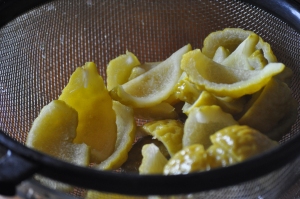


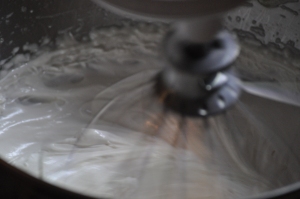

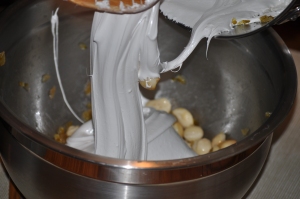

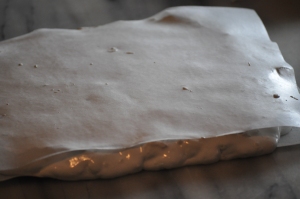

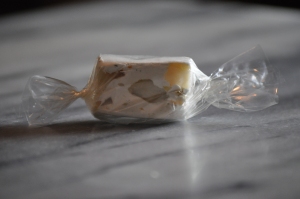

[…] These candies were lovingly created by someone who was a postdoc in a lab where I work at Princeton University. Erin Smith, you are a woman of hidden talents! She made them with her boyfriend Dave, and I’d say they are quite professional. I sampled a couple, so can vouch for the delicious factor. I am SO impressed! (And you can read all about their culinary endeavors on their blog.) […]
This is fascinating stuff, I love that you are so interested in nougat! I was amazed at all the varieties I found when I went to Italy. I’m half Italian and I never knew it was such a big deal. Now I see interesting types in good Italian markets here, especially for Easter.
I first saw kaffir limes when David Karp (the “Fruit Detective”) did a big exotic citrus presentation to the old Flavor club at Princeton (miss that club!). He had about 60 varieties of unusual citrus that evening, some were hybrids that didn’t even have names yet, just grower’s numbers.
What you say about lavender honey made with extracts is so true, I just threw some out, it tasted horrible and now I know why. A great blog guys!
Thanks Faith! Yeah, we had no idea that nougat was this good. We’ve found some good nougats at Mona Lisa, an Italian market here, too. We’ll have to check around Easter to see what else they get in.
I missed the Flavor club when I was out there — that sounds like a really neat event!
excellent knowledge of nougat. bravo